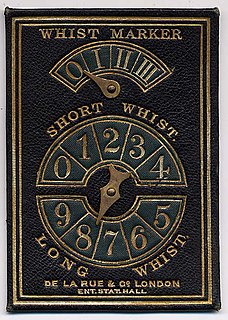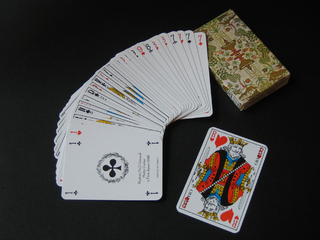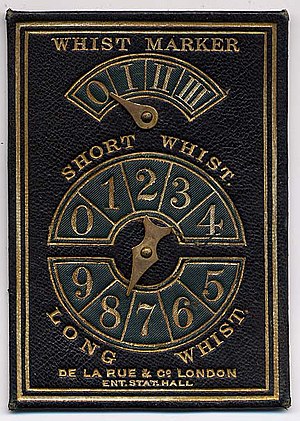
Contract bridge, or simply bridge, is a trick-taking card game using a standard 52-card deck. In its basic format, it is played by four players in two competing partnerships, with partners sitting opposite each other around a table. Millions of people play bridge worldwide in clubs, tournaments, online and with friends at home, making it one of the world's most popular card games, particularly among seniors. The World Bridge Federation (WBF) is the governing body for international competitive bridge, with numerous other bodies governing bridge at the regional level.
Oh Hell, Oh Pshaw or Nomination Whist is a trick-taking card game of British origin in which the object is to take exactly the number of tricks bid. Unlike contract bridge and spades, taking more tricks than bid is a fail. It was first described by B. C. Westall around 1930 and originally called Oh! Well. It was said to have been introduced into America via the New York clubs in 1931. It has been described as "one of the best round games."

Pinochle, also called pinocle or penuchle, is a trick-taking, Ace-Ten card game typically for two to four players and played with a 48-card deck. It is derived from the card game bezique; players score points by trick-taking and also by forming combinations of cards into melds. It is thus considered part of a "trick-and-meld" category which also includes the game belote. Each hand is played in three phases: bidding, melds, and tricks. The standard game today is called "partnership auction pinochle".

A trick-taking game is a card or tile-based game in which play of a hand centers on a series of finite rounds or units of play, called tricks, which are each evaluated to determine a winner or taker of that trick. The object of such games then may be closely tied to the number of tricks taken, as in plain-trick games such as Whist, contract bridge and Spades, or to the value of the cards contained in taken tricks, as in point-trick games such as Pinochle, the Tarot family, Briscola, and most evasion games like Hearts. Trick-and-draw games are trick-taking games in which the players can fill up their hands after each trick. In most variants, players are free to play any card into a trick in the first phase of the game, but must follow suit as soon as the stock is depleted. Trick-avoidance games like Reversis or Polignac are those in which the aim is to avoid taking some or all tricks.

Whist is a classic English trick-taking card game which was widely played in the 18th and 19th centuries. Although the rules are simple, there is scope for scientific play.

The card game auction bridge was the third step in the evolution of the general game of bridge. It was developed from bridge whist in 1904, possibly by 1900. Auction bridge was the precursor to contract bridge. Its predecessors were whist and bridge whist.

Piquet is an early 16th-century plain-trick card game for two players that is still popular today.

Spades is a trick-taking card game devised in the United States in the 1930s. It can be played as either a partnership or solo/"cutthroat" game. The object is to take the number of tricks that were bid before play of the hand began. Spades is a descendant of the Whist family of card games, which also includes Bridge, Hearts, and Oh Hell. Its major difference as compared to other Whist variants is that, instead of trump being decided by the highest bidder or at random, the Spade suit always trumps, hence the name.

Solo Whist, sometimes known as English Solo or simply Solo, is a trick-taking card game for four players. Despite the name it is not related to Whist, but derives from an early form of Boston played in the Low Countries, whose direct ancestor, in turn, was the 17th-century Spanish game of Ombre. Its major distinctive feature is that one player often plays against the other three. However, players form temporary alliances with two players playing against the other two if "Prop and Cop" is the current bid. It requires four players using a standard 52 card deck with no jokers. Aces are high and the deal, bidding and play are clockwise.
Rubber bridge is a form of contract bridge played by two competing pairs using a particular method of scoring. A rubber is completed when one pair becomes first to win two games, each game presenting a score of 100 or more contract points; a new game ensues until one pair has won two games to conclude the rubber. Owing to the availability of various additional bonus and penalty points in the scoring, it is possible, though less common, to win the rubber by amassing more total points despite losing two games out of three. Rubber bridge involves a high degree of skill but there is also a fair amount of luck involved in who gets the best cards.

Duplicate bridge is the most widely used variation of contract bridge in club and tournament play. It is called duplicate because the same bridge deal is played at each table and scoring is based on relative performance. In this way, every hand, whether strong or weak, is played in competition with others playing identical cards, and the element of skill is heightened while that of chance is reduced. Duplicate bridge stands in contrast to rubber bridge where each hand is freshly dealt and where scores may be more affected by chance in the short run.

Bid whist is a partnership trick-taking variant of the classic card game whist. As indicated by the name, bid whist adds a bidding element to the game that is not present in classic whist. Bid whist, along with spades, remains popular particularly in U.S. military culture and a tradition in African-American culture.

Preferans or Russian Preference is a 10-card plain-trick game with bidding, played by three or four players with a 32-card Piquet deck. It is a sophisticated variant of the Austrian game Préférence, which in turn descends from Spanish Ombre and French Boston. It is renowned in the card game world for its many complicated rules and insistence on strategical approaches.
These terms are used in contract bridge, using duplicate or rubber scoring. Some of them are also used in whist, bid whist, the obsolete game auction bridge, and other trick-taking games. This glossary supplements the Glossary of card game terms.
There are two main categories of scoring in contract bridge: duplicate and rubber scoring. While based upon the same basic elements of scoring, they differ in how the elements are applied to individual deals and in how these are then totaled. Chicago, being a variant of rubber bridge, uses an adaptation of rubber bridge scoring. Duplicate bridge has many variations for scoring, comparing and ranking the relative performance of partnerships and teams playing the same deals as their competitors.
Sueca is a 4 player-partnership point trick-taking card game of the Ace-Ten family, and a popular variant of the Bisca card game. The game is played in Portugal, Brazil, Angola and other Portuguese communities. Its closest relative is the very similar German game Einwerfen.

Catch the Ten is a point trick-taking card game which first appeared in The American Hoyle of 1868 and is alternatively called Scotch Whist, although evidence shows that it is in fact of German origin. Unlike standard whist, it is played with a deck of only 36 cards, with Six (low) up to the Ace (high) of each suit. The order of trumps has the Jack high.
Serbian whist is a variant of whist. It is popular in Serbia, and there it is simply called "whist".

Boston is an 18th-century, trick-taking, card game played throughout the Western world apart from Britain, forming an evolutionary link between Hombre and Solo Whist. Apparently named after a key location in the American War of Independence, it is probably a French game which was devised in France in the 1770s, combining the 52-card pack and logical ranking system of partnership Whist with a range of solo and alliance bids borrowed from Quadrille. Other lines of descent and hybridization produced the games of Twenty-five, Préférence and Skat. Its most common form is known as Boston de Fontainebleau or French Boston.

The following is a glossary of terms used in card games. Besides the terms listed here, there are thousands of common and uncommon slang terms. Terms in this glossary should not be game-specific, but apply to a wide range of card games. For glossaries that relate primarily to one game or family of similar games, see Game-specific glossaries.














